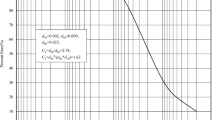Abstract
Granulometric and aggregate content plays an essential role in the estimation of engineering-geological features of cohesive soil. The paper describes the results of studies of the chemical and mineral composition of aggregate fractions, the whole mass of soil samples and their clayey fractions. It has been proved that compounds of trivalent iron as well as carbonates/if they abound/play an important role in the structure of waterproof aggregates, but no influence of the organic matter has been observed. Calcium montmorillonites are the main clay minerals and they are much more concentrated in aggregates than the hydromicas and chlorites also occurring in clayey fractions. Pores are present both in the whole mass of soil and in the aggregates. Locally the surface of pores and edges of the aggregates are composed either of iron compounds or carbonates or streaks of clayey minerals, which is likely to increase the waterproofness of the aggregates. The results of the research can also be applied to the same type of soil from the regions of Central and Northern Europe.
Résumé
La composition granulométrique et la présence d'agrégats sont essentielles dans l'appréciation des propriétés des sols cohérents. L'article présente les résultats des recherches concernant la composition chimique et minéralogique des constituants des fractions d'agrégats ainsi que cells des échantillons globaux de sols et de leurs argiles dominants. On démontre que dans la construction des agrégats hydrofuges, un rôle important est joué par les combinaisons du fer trivalent et par les carbonates, lorsqu'ils sont en grande quantité. On a remarqué simultanément que les substances organiques n'ont pas d'influence. Les principaux minéraux argileux sont des montmorillonites calciques plus concentrés dans les agrégats que d'autres minéraux argileux comme les hydromicas et les chlorites. Dans toute la masse du sol ainsi que dans les agrégats il y a des pores. Les pores et aussi les bords des agrégats sont enrobés localement par les minéraux ferrugineux ou bien par les carbonates ou par des minéraux argileux disposés radialement ce qui augmente la résistance des agrégats à l'eau. Les conclusions des recherches faites peuvent s'appliquer aux mêmes types de sols sur l'ensemble de l'Europe centrale et du Nord.
Similar content being viewed by others
References
ANDRZEJESCZAK B., 1981: Dependence of soil aggregation and reaggregation on changes in moisture content. Bull. Int. Assoc. Engin. Geol. V. 24.
ASSBURY E., MYŚLIŃSKA E., 1975: Oznaczenie zawartości węglanów i substancji organicznej. Metody badań gruntów spoistych, Weyd, Geol. Warszawa.
BIRECKI M., GASTOL J., 1961: Charakterystyka niektórych elementów skŀadowych gruzeŀków glebowych spod róznych roślin uprawnych. cz. II. Roczn. Nauk Roln., t. 84-a-3, Warszawa.
CHAN D.W., 1969: Organominieralnyje sojedinierija i struktura poczwy. Izd. Nauka, Moskwa.
EDWARDS A.P., BREMNER J. M., 1967: Microaggregates in Soils. Journ. of Soil Science, vol. 18, nr 1.
HEINONEN R. 1955: Soil Aggregation in Relation to Texture and Organic Matter. Agricult. Research Cent. Dep. of Soil Scien., Helsinki.
KAWAGUCHI K., KITA D., 1957: Mechanical and Chemical Constituents of Water—Stable Aggregates of Paddy Soil with Relationship to the Aggre-Size. Soil and Plant Food. vol. 3, nr. 1
ĿARIONOW A.K., 1966. Inzynierno-gieologiczeskoje izuczenije strucktury osadocznych porod/struktura grunta. Izd. Niedra. Moskwa.
MICZYŃSKI J., 1957: Proste metody określania wodotrwaŀości agregatów glebowych. Annales Universitatis Mariae Curie-Skŀodowska, vol. XII. 4 Secio E.
MUSIEROWICZ A., 1961. Gleboznawstwo ogólne. PWRiL, Warszawa.
STANGENBERG M., 1936a: Wapń w jeziorach. Wszechświat nr 7.
STANGENBERG M., 1936b: Szkic limnologiczny na tle stosunków hydrochemicznych pojezierza suwalskiego. “Suchar” i “Jeziorko” jako studium przejściowe zanikania jezior. Inst. Bad. Lasów Państw. Seria A. nr 19 Warszawa.
STANGENBERG M., 1937: a. Charkaterystyka limnologiczna jezior grupy Kleszczowskiej i Hańczańskiej, b. Materiaŀy do znajomości przebiegu cyrkulacji wiosennej w jeziorach suwalszczyzny, c. Fosforany, azotany, siarczany i chlorki jezior wigierskich w czasie cyrkulacji jesiennej. Inst. Bad. Lasówx Państw., Seria A, nr 23, 24, 25, Warszawa.
STANGENBERG M., 1938: Skŀad chemiczny osadów gŀę binowych jezior Suwalszczyzny. Inst. Bad. Lasów Państw., Rozprawy i Sprawozdania, Seria A, nr 31.
TJULIN A.F., 1955: Waprosy poczwiennoj struktury w lesu. Poczwowiediennije nr 1.
WILIAMS W., 1950. Gleboznawastwo. PWRiL. Warszawa.
WIĘCKOWSKI K., 1966: Osady denne Jeziora Mikoŀajskiego. Prace Geograf. PAN nr 57.
Author information
Authors and Affiliations
Rights and permissions
About this article
Cite this article
Bozenna, A. The interrelationship between chemical and mineral composition and aggregation and reaggregation of postlake cohesive soil. Bulletin of the International Association of Engineering Geology 39, 59–65 (1989). https://doi.org/10.1007/BF02592536
Published:
Issue Date:
DOI: https://doi.org/10.1007/BF02592536




